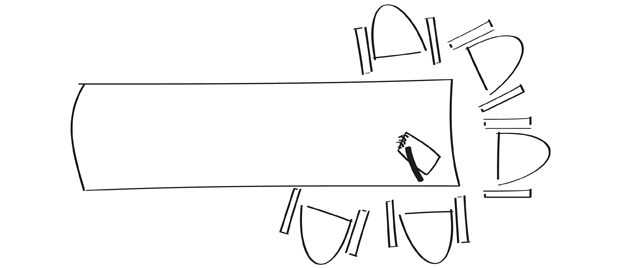I run and attend a lot of meetings in my day to day work. The one common thread to all meetings is that everyone claims to hate them. There’s a lot that can be improved in meetings by applying standard and not so standard facilitation techniques. But that’s often hard and takes a lot of practice.
In the meantime I thought I’d share a simple technique that I’ve found to be hugely effective in running meetings involving small groups. Between 2 and 6 people.
It has nothing at all to do with the agenda or the stickies or fancy brainstorming techniques. It’s simply about how you sit.
The Theory
Really and truly this all begins with Socrates and his peripatetic school of philosophers. He believed that walking about while talking was a better way of exploring philosophy because it forced people, even of differing opinions, to ‘walk to same path’ together.
Modern thinkers and researchers describe it differently but the principle is unchanged. Edward de Bono came up with the concept of “parallel thinking” which underpins the success of his 6 Thinking Hats method. The idea being that any subject under discussion has many facets including factual data, pros and cons and needs clinical evaluation as well as creative ideas. A group is more effective if they look at each of these facets in parallel rather than confrontationally. I.e. everyone first looks at pros together, then cons together, then facts, and so on. This gives the group a sense that they are exploring all facets of a subject together instead of arguing for particular points of view.
Anthropologists Tim Ingold and Joe Vergunst also deal with this topic in their book Ways of Walking in which they explore the value of friends “walking abreast” and the closeness and understanding that engenders. (I admit I haven’t personally read this particular book but I’ve had the detailed summary from my other half who works with him closely. Ingold’s stuff is worth reading by the way, particularly his book Lines: A bref history.)
The Practicalities
So how do you apply this in day to day life? It’s not alway easy to take your boss for a 30 minute walk in the Socratic fashion.
When you have a 1-1 meeting with a colleague or client, this is the default position most people take:
Subconsciously this sets us up a confrontational context. It is subtly reminiscent of interviews, strongly held opinions and power struggles. So many people fall into a non-collaborative mode of thinking focusing instead on oneupmanship and “winning” an argument.
A better way is to sit like this:
 Sitting not quite side by side but not facing each other creates the feeling of facing a problem or decision together. You’re not staring each other in the eyes and you can see what each other is writing creating a sense of openness and trust.
Sitting not quite side by side but not facing each other creates the feeling of facing a problem or decision together. You’re not staring each other in the eyes and you can see what each other is writing creating a sense of openness and trust.
For larger groups, you can create the same effect by not spreading evenly around a bigger table and instead clustering more closely towards one end:
These ideas work equally well in a variety of scenarios like team meetings, working lunches/meetings, 1-to-1 reviews and even interviews.
Trying it out
Is simple. The next time you have a meeting quietly move your chair to take up a position as I described above. There’s no need to make a big deal out of it. If its a bigger meeting and you’re chairing it simply ask attendees to politely come closer indicating where you’d like them to sit.
After you start doing this for a while it becomes easier and you’ll start seeing your meetings progress more constructively and collaboratively.
Full refund guaranteed. Just follow me on Twitter.

